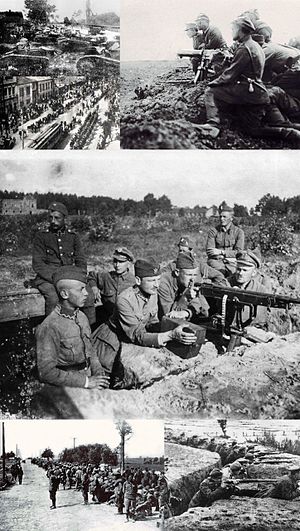Polish-Soviet War
| Polish–Soviet War | |||||||
|---|---|---|---|---|---|---|---|
| Part of the Russian Civil War | |||||||
 Top left: Polish Renault FT tanks of the Polish 1st Tank Regiment during the Battle of Dyneburg, January 1920 Below left: Polish and Ukrainian troops in Khreshchatyk during the Kiev Offensive, 7 May 1920 |
|||||||
|
|||||||
| Belligerents | |||||||
|
|
|
||||||
| Commanders and leaders | |||||||
|
(Commissar of Military and Naval Affairs) (Commander-in-Chief) (Western Front) (Lviv front) (Southwestern Front) (1st Cavalry Army) |
|
||||||
| Strength | |||||||
| From ~50,000 in early 1919 to almost 800,000 in summer 1920 | From ~50,000 in early 1919 to ~738,000 in August 1920 | ||||||
| Casualties and losses | |||||||
|
Estimated 60,000 killed |
About 47,000 killed 113,518 wounded 51,351 taken prisoner |
||||||
Below left: Polish and Ukrainian troops in Khreshchatyk during the Kiev Offensive, 7 May 1920
Top right: Polish Schwarzlose M.07/12 machine gun nest during the Battle of Radzymin,August 1920.
Middle: Polish defences with a machine gun position near Miłosna, in the village of Janki, Battle of Warsaw, August 1920
Bottom left: Russian prisoners on the road between Radzymin and Warsaw after the attack by the Red Army on Warsaw.
Polish victory
Estimated 60,000 killed
80,000 – 157,000 taken prisoner
The Polish–Soviet War (February 1919 – March 1921) was an armed conflict that pitted Soviet Russia and Soviet Ukraine against the Second Polish Republic and the Ukrainian People's Republic over the control of an area equivalent to today's Ukraine and parts of modern-day Belarus. Ultimately the Soviets, following on from their Westward Offensive of 1918–19, hoped to fully occupy Poland.
Although united under communist leadership, Soviet Russia and Soviet Ukraine were theoretically two separate independent entities since the Soviet republics did not unite into the Soviet Union until 1922.
Poland's Chief of State, Józef Piłsudski, felt the time was right to expand Polish borders as far east as feasible, to be followed by a Polish-led Intermarium federation of East-Central European states as a bulwark against the re-emergence of German and Russian imperialism. Lenin, meanwhile, saw Poland as the bridge the Red Army had to cross to assist other communist movements and bring about other European revolutions. By 1919, Polish forces had taken control of much of Western Ukraine, emerging victorious from the Polish–Ukrainian War. The West Ukrainian People's Republic, led by Yevhen Petrushevych, had tried to create a Ukrainian state on territories to which both Poles and Ukrainians laid claim. At the same time in the Russian part of Ukraine Symon Petliura tried to defend and strengthen the Ukrainian People's Republic, but as the Bolsheviks began to gain the upper hand in the Russian Civil War, they started to advance westward towards the disputed Ukrainian territories, causing Petliura's forces to retreat to Podolia. By the end of 1919, a clear front had formed as Petliura decided to ally with Piłsudski. Border skirmishes escalated following Piłsudski's Kiev Offensive in April 1920. The Polish offensive was met by an initially successful Red Army counterattack. The Soviet operation pushed the Polish forces back westward all the way to the Polish capital, Warsaw, while the Directorate of Ukraine fled to Western Europe. Meanwhile, Western fears of Soviet troops arriving at the German frontiers increased the interest of Western powers in the war. In midsummer, the fall of Warsaw seemed certain but in mid-August, the tide had turned again, as the Polish forces achieved an unexpected and decisive victory at the Battle of Warsaw. In the wake of the Polish advance eastward, the Soviets sued for peace and the war ended with a ceasefire in October 1920.
...
Wikipedia
